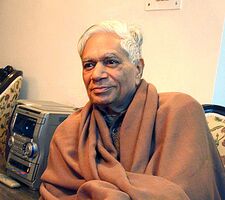Chandra, L.: Difference between revisions
m (Text replace - "publicationtype" to "classification") |
No edit summary |
||
| (9 intermediate revisions by 2 users not shown) | |||
| Line 1: | Line 1: | ||
{{Person | |||
|MainNamePhon=Lokesh Chandra | |||
|SortName=Chandra, Lokesh | |||
|namefirst=Lokesh | |||
|namelast=Chandra | |||
|PersonType=Authors of English Works; Editors; Translators | |||
|bio=Prof. Lokesh Chandra (born 11 April 1927) is a prominent scholar of the Vedic period, Buddhism and the Indian arts. He was the president of Indian Council for Cultural Relations during 2014–2017. He has also served as a member of the Indian Rajya Sabha, Vice-President of the Indian Council for Cultural Relations, and Chairman of the Indian Council of Historical Research. In 2006 he was conferred with Padma Bhushan by the Indian Government.<br> | |||
He is the son of the famous Sanskrit scholar, linguist and politician Raghu Vira. After obtaining a master's degree at the University of the Punjab in Lahore in 1947, he edited the Gavamayana portion of the Vedic work Jaiminiya Brahmana with the help of newly discovered manuscripts. Chandra went to the Netherlands to study Old Javanese with the Indologist Jan Gonda at Utrecht University, where he obtained a Ph.D. with the dissertation ''Jaiminiya Brahmana of the Samaveda II.1-80'' in March 1950. Among them are classics like his ''Tibetan-Sanskrit Dictionary'', ''Materials for a History of Tibetan Literature'', ''Buddhist Iconography of Tibet'', and his ''Dictionary of Buddhist Art'' in about 20 volumes. ([https://en.wikipedia.org/wiki/Lokesh_Chandra Source Accessed Apr 2, 2021]) | |||
|images=File:Chandra Lokesh Wikipedia.jpg | |||
|yearbirth=1927/04/11 | |||
|associatedwebsite=[https://archive.org/details/lokeshchandracompletepublications_202004_876_o/page/n7/mode/2up List of Publications] | |||
|HasDrlPage=Yes | |||
|HasLibPage=Yes | |||
|phduniversity=Utrecht University | |||
|education=* PhD, Utrecht University, 1950. Dissertation: Jaiminiya Brahmana of the Samaveda II.1-80." | |||
[ | * MA, University of the Punjab, Lahore, 1947 | ||
|BuNayDefProvComplex=No | |||
== Publications == | |BuNayWheelTurnComplex=No | ||
|BuNayYogaMadhyaComplex=No | |||
|BuNayZhenRangComplex=No | |||
|BuNayVehiclesComplex=No | |||
|BuNayAnalyticMeditComplex=No | |||
|BuNayEmptyLuminComplex=No | |||
|IsInGyatsa=No | |||
|classification=People | |classification=People | ||
}} | }} | ||
Latest revision as of 17:07, 29 September 2022
| PersonType | Category:Authors of English Works Category:Editors Category:Translators |
|---|---|
| FirstName / namefirst | Lokesh |
| LastName / namelast | Chandra |
| MainNamePhon | Lokesh Chandra |
| SortName | Chandra, Lokesh |
| bio | Prof. Lokesh Chandra (born 11 April 1927) is a prominent scholar of the Vedic period, Buddhism and the Indian arts. He was the president of Indian Council for Cultural Relations during 2014–2017. He has also served as a member of the Indian Rajya Sabha, Vice-President of the Indian Council for Cultural Relations, and Chairman of the Indian Council of Historical Research. In 2006 he was conferred with Padma Bhushan by the Indian Government. He is the son of the famous Sanskrit scholar, linguist and politician Raghu Vira. After obtaining a master's degree at the University of the Punjab in Lahore in 1947, he edited the Gavamayana portion of the Vedic work Jaiminiya Brahmana with the help of newly discovered manuscripts. Chandra went to the Netherlands to study Old Javanese with the Indologist Jan Gonda at Utrecht University, where he obtained a Ph.D. with the dissertation Jaiminiya Brahmana of the Samaveda II.1-80 in March 1950. Among them are classics like his Tibetan-Sanskrit Dictionary, Materials for a History of Tibetan Literature, Buddhist Iconography of Tibet, and his Dictionary of Buddhist Art in about 20 volumes. (Source Accessed Apr 2, 2021) |
| YearBirth | 1927/04/11 |
| associatedwebsite | List of Publications |
| phduniversity | Utrecht University |
| education |
|
| IsInGyatsa | No |
| Other wikis |
If the page does not yet exist on the remote wiki, you can paste the tag |

